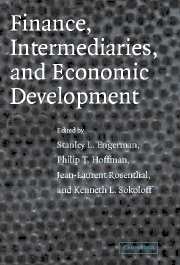Book contents
- Frontmatter
- Contents
- List of Contributors
- Preface
- Introduction
- I FINANCIAL INTERMEDIARIES IN EUROPE
- 1 Markets and Institutions in the Rise of London as a Financial Center in the Seventeenth Century
- 2 The Paris Bourse, 1724–1814: Experiments in Microstructure
- 3 No Exit: Notarial Bankruptcies and the Evolution of Financial Intermediation in Nineteenth Century Paris
- II FINANCIAL INTERMEDIARIES IN THE AMERICAS
- III OTHER FORMS OF INTERMEDIATION
- Afterword: About Lance Davis
- Index
1 - Markets and Institutions in the Rise of London as a Financial Center in the Seventeenth Century
Published online by Cambridge University Press: 24 July 2009
- Frontmatter
- Contents
- List of Contributors
- Preface
- Introduction
- I FINANCIAL INTERMEDIARIES IN EUROPE
- 1 Markets and Institutions in the Rise of London as a Financial Center in the Seventeenth Century
- 2 The Paris Bourse, 1724–1814: Experiments in Microstructure
- 3 No Exit: Notarial Bankruptcies and the Evolution of Financial Intermediation in Nineteenth Century Paris
- II FINANCIAL INTERMEDIARIES IN THE AMERICAS
- III OTHER FORMS OF INTERMEDIATION
- Afterword: About Lance Davis
- Index
Summary
Informal networks are an important technology in financial development, and successful formal systems have usually replaced previously successful informal systems. Recent examples in the U.S. include the development of venture capital firms and the rise of NASDAQ from the previous over-the-counter market for small capital equities. For earlier examples, Lance Davis has highlighted the importance of personal relationships for effective financial intermediation in the early national development of the U.S. economy. The Savings Bank of Baltimore, while drawing on the deposits of numerous small investors, was owned by the wealthy few of Baltimore, the 134 original incorporators responsible for electing annually the twenty-five directors who oversaw the daily operations of the bank. Over time, the bank became professionally managed, maintaining an arm's length relationship to the borrowing needs of its stockholders. For New England textile mills, which borrowed both short and long term from a wide range of intermediaries and individuals in the period 1840–1860, Lance Davis also found that individual lenders often reappeared in a given firm's accounts as the source of special loans in times of crisis, often at higher rates than were enforceable under usury laws.
In addition to the evidence of important personal, presumably informal, relationships on both the savings and the investment sides of financial intermediation in the early U.S. economy, Davis noted a number of English precedents. Savings banks in the U.S. were typically based on the ideas of the national savings banks formed in Britain after the Napoleonic Wars.
- Type
- Chapter
- Information
- Finance, Intermediaries, and Economic Development , pp. 11 - 33Publisher: Cambridge University PressPrint publication year: 2003
- 2
- Cited by

